Chakras
Introduction:
Chakras were first documented in the ancient Hindu text of knowledge, the Vedas. The term Chakra comes from the Sanskrit word meaning “wheel”. Chakras are also described as padmas (lotuses).
When visualising chakras it may be useful to perceive or experience them as spinning vortices of energy spiralling through the body from front to back-like little whirlpools, or their lotus as depicted on the relevant yantra.
When we speak about the position of chakras within the self we enter the realms of subtle anatomy-the pranic sheath or layer. In Sanskrit this layer is called Pranamaya kosha.
Yoga anatomy recognises that the pranamaya kosha has a system of nadis, or energy channels-some 72,000! Nadi means current or flow.
Prana- or life force-circulates throughout these channels, sometimes well, sometimes not so well, sometimes throughout certain channels and not through others.
The channels can become “blocked” or sluggish, which can then be perceived physically or mentally as illness. In a similar way traditional Chinese medicine recognises energy as chi, running through meridians.
Where there is a big convergence of several energy channels, a chakra is created and these, too, can become “blocked” creating an imbalance in physical, mental or emotional health and ultimately spiritual health.
Animals are also recognised to have a also pranic layer or sheath.
There are 3 major nadis within pranamaya kosha:
- Sushumna
- Ida
- Pingala
Sushumna can be perceived as running parallel to the spinal cord, which is an extension of the brain. It is at certain points along Sushumna nadi that the chakras lie.
It is generally recognised that there are 7 major chakras or energy centres, however there are many more than this, which are less well known.
Five of the major chakras relate to both a sense and an element. All have a mantra-a bija-or seed mantra, an animal, a god or goddess, a colour, a lotus flower and a yantra,
A yantra is a geometric, sacred illustration. They are all ways of aiding concentration and focus.
The closest physiological counterpart to chakras is both nerve ganglia and the endocrine system, however this is not exact as chakras and nadis belong to pranamaya kosha whereas nerves and the endocrine system are part of annamaya kosha (the gross or physical sheath)
Over the evolution of time various traditions, even within yoga, will have some variations in their visualisations and representations of energy centres so the following is to be taken as a guide.
The following is the first in a series of 3 blogs about Chakras:
MULADHARA ( Mula-root, Adhara-place)
 This is known as the base chakra or Earth centre. It lies at the base of Sushumna nadi-in males level with the perineum and in females level with the cervix.
This is known as the base chakra or Earth centre. It lies at the base of Sushumna nadi-in males level with the perineum and in females level with the cervix.
Its bija,or seed,mantra is LAM-pronounced LAANG.
It is related to the sense of smell and the element of Earth.
Its yantra is represented as a deep red lotus flower with 4 petals. Within the lotus is a yellow square, containing an inverted red triangle. Within this is a smoky coloured lingum ( a phallic represenation of the god of yoga, Shiva), encirled by a golden serpent, colied around it 3and half times. This serpent represents the slumbering Kundalini energy or Shakti. Kundalini is the source of all energy-emotional, physical, sexual,mental, psychic and spiritual..
Although it is all one energy it takes on the qualities and attributes of the centres through which it manifests.
The goal of yoga is to awaken slumbering kundakini energy through various practices so that it rises through the chakras in the form of shakti (lit.ability, yet often translated as” power”) to eventually unite with Shiva-pure consciousness.
The animal associated with this centre is a 7 trunked elephant, symbolising the stability of the earth.
The deity is Brahma,the preserver, Dakini is the consort.
Muladhara controls what is perceived to be solid in the body-bone and muscle, skin, teeth and nails.It is concerned with the most basic energy of all-self -preservation. Its related endocrine function is the gonads-testes and ovaries and the adrenal glands-the flight or fight hormones

 A yoga asana that really resonates with Muladhara Chakra is balasana or child’s pose. There are several variations illustrated here, from the more traditional to restorative versions using bolsters, blankets or even just a pad to cushion the forehead. Hibernation childpose is when you need to escape from the works for a while.
A yoga asana that really resonates with Muladhara Chakra is balasana or child’s pose. There are several variations illustrated here, from the more traditional to restorative versions using bolsters, blankets or even just a pad to cushion the forehead. Hibernation childpose is when you need to escape from the works for a while.
A mudra to bring more energy into Muladhara chakra is Prithivi (Earth) mudra.It stimulates the sense of smell and improves both physical and mental equilibrium. It can be used whilst walking as well as when seated. It is created by connecting the thumb (fire element) with the ring finger ((earth element). The other fingers remain straight, yet not locked. Backs of hands rest on knees/thighs. Can be practiced for 15 minutes or more if comfortable .
Either at the same time or separately, you may wish to visualize a deep red inverted triangle at the womb space or perineum.
If you would like a more breath focused practice, visualize a deep red, 4-petalled lotus flower. On the inhale the petals open, on the exhale, they close.
NEXT TIME…Svadisthana chakra

